A new awareness of racism and systemic bias arose in the summer of 2020 during the pandemic. After witnessing the murder of George Floyd and the many more examples of inequity that we’ve seen recently, the early childhood field along with many other groups have recognized the urgent need for understanding of systemic bias and racism and the need for action. Organizations across disciplines in the early childhood field have developed educational webinars, publications and videos to address these needs and provide resources to promote understanding and support for early learning and care professionals, families and children in building a more equitable, inclusive world.
The MAP Team has been gathering the newest educational resources for early learning and care professionals. They include publications, webinars and videos in the section entitled, “Resources to Help You Learn About Equity and Anti-Racism” and videos, activities and books for families and care providers in the “Multi-media Resources for Families and Care Providers” area. In addition, we’ve listed links to many other resources on this topic posted earlier on the MAP website.
The resources have been organized:
- Resources to Help You Learn About Equity and Anti-Racism
- Publications
- Webinars
- Videos
- Multi-Media Resources for Families and Care Providers
“What About People Like Me?” Teaching Preschoolers about Segregation and “Peace Heroes”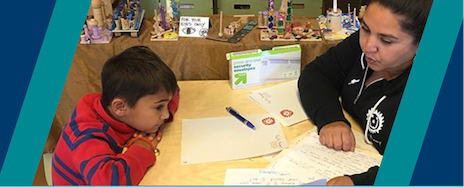
Teaching Young Children, NAEYC | February/March 2020“As part of the anti-bias curriculum at the preschool where I teach, we study the life of Dr. Martin Luther King Jr. throughout the year. Learning about Dr. King’s life provides us with a wonderful opportunity to reflect on the principles he stood for. These are ideas my colleagues and I believe are very appropriate for preschoolers to explore and revisit often.” This article reports a thoughtful discussion conducted in a preschool classroom that explored injustices experienced by people of color.
Added: Mar 2022
An Inclusive Anti-Bias Framework for Teaching and Learning About Race with Young Children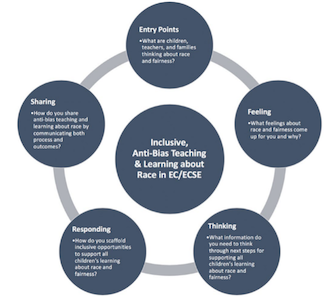
Young Exceptional Children | June 2019STEMIE provides access to an article from Young Exceptional Children on how we can use an inclusive anti-bias framework to teach and learn about race with young children. This article is made freely accessible through April 1, 2022 thanks to their partners at the Division for Early Childhood (DEC).
In this article, we describe an inclusive, anti-bias approach for teaching and learning about race in EC/ECSE. To this end, we (a) discuss the importance of addressing race in EC/ECSE classrooms; (b) introduce an inclusive, anti-bias framework for teaching and learning about race in EC/ECSE; and (c) use an example from practice to illustrate and unpack each component of the framework.
Added: Mar 2022
Creating Equitable Learning Environments for Young Children of Color (PDF)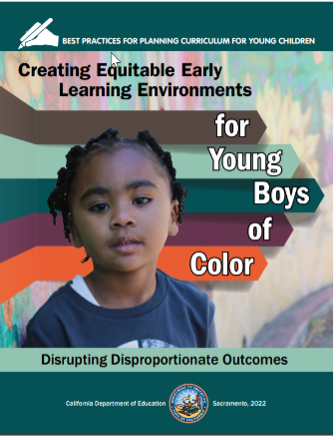
California Department of Education | Published: 2022The California Department of Education Early Education Division (EED) has released a new online publication titled Creating Equitable Early Learning Environments for Young Boys of Color. This free publication was written primarily for child care and early education providers and program and school leaders.
"Early childhood educators are uniquely positioned to influence positive change for Boys of Color. This book provides teachers and program leaders with a helpful roadmap for improving racial equity through strengthening racial awareness, addressing implicit bias, and creating culturally responsive environments that are safe, affirming, and engaging for Boys of Color and their families." — Tony Thurmond, State Superintendent of Public Instruction
Added: Sep 2023
Dis/ability Critical Race Studies (DisCrit) for Inclusion in Early Childhood Education: Ethical Considerations of Implicit and Explicit BiasZero to ThreeThis article explores the ethical obligation of those in the early care and education field to deconstruct ableism (and other–isms, such as racism, sexism, classism) and to reconstruct an understanding of social identity that is strengths-based and affirming. The authors describe the Dis/ability Studies and Critical Race Theory (DisCrit) framework of understanding ableism and provide examples of potential solutions for early childhood providers to explore the role of bias in inclusion practices and deconstruct dis/ability to enact systemic change for young children with dis/abilities and their families.
Added: Jun 2021
Equity: Understanding Common Measures of Disproportionality (PDF)NCPMI | January 15, 2021“This fact sheet was developed to provide illustrations of the measures used to understand disproportionality related to various groups of children and a particular factor or outcome. This document focuses on children grouped by race/ethnicity. However, there are other groups you might also want to review (e.g., gender, dual language learners, children with IEPs). We provide an example of the calculation of these measures using the completion of a Behavior Incident Report (BIR) for a child. These measures of disproportionality are also used to examine other variables of interest, including suspensions, expulsions, or referrals for services.”
Added: Jun 2021
How Racism Can Effect Child Development (Infographic)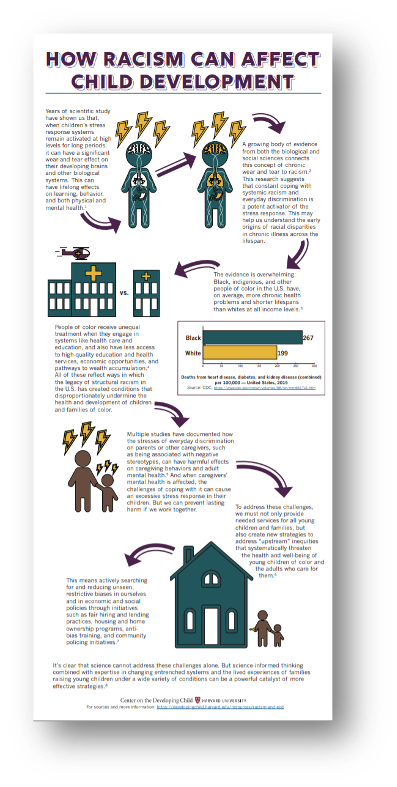
Center for the Developing Child, Harvard University | 2020It’s time to connect these dots. This infographic explains in basic terms how racism, in particular, gets “under the skin” and affects learning, behavior, and lifelong health. There is much more to say, but by starting with a shared understanding, we can work together toward creative strategies to address these long-standing inequities. More information and resources are available in this article:
More information and resources are available in the article Connecting the Brain to the Rest of the Body: Early Childhood Development and Lifelong Health are Deeply Entwined.
Added: Jan 2021 | Updated: Jun 2021
If Equity is a Priority, UDL is Must
Katie Novak | March 21, 2021“When we design the same learning pathways for all learners, we might tell ourselves we are being fair, but in fact, single pathways are exclusionary. Beverly Daniel Tatum, author of the critically acclaimed book, Why Are All The Black Kids Sitting Together in the Cafeteria? And Other Conversations About Race, challenges us to focus on impact over intentions. It may not be our intent to exclude our learners, but the reality is that many students do not have opportunities to learn at high levels or to access curriculum and instruction that is accessible, engaging, culturally sustaining, and linguistically appropriate.”
“Luckily, there is a framework that rejects these one-size-fits-all solutions and empowers educators to proactively design learning experiences so all students can increase their brainpower and accelerate and own their learning. The framework is Universal Design for Learning (UDL).” In this article Katie Novak explains how UDL makes equity in education possible.
Added: Jun 2021
Moving Upstream: Confronting Racism to Open Up Children’s Potential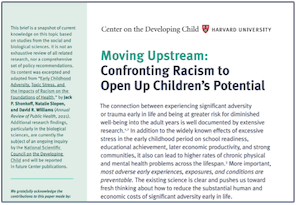
Harvard Center for the Developing Child This brief discusses how racism creates conditions that harm the well-being of children and families, and the need to go “upstream” and create policy solutions to address the source of structural, cultural, and interpersonal forms of racism. It is one of the resources in a guide from Harvard Center for the Developing Child that addresses the inequities in early childhood.
Added: Mar 2022
Our Identities, Ourselves: A Guide to Anti-Racist Data Collection for: Case Workers and Other Frontline Staff (PDF)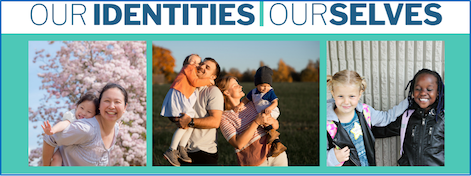
Center for the Study of Social Policy | September 2021The Center for the Study of Social Policy (CSSP), in partnership with Casey Family Programs, presents this four page guide to share best practices for collecting data about race, ethnicity, and other personal information including sexual orientation, gender identity and expression (SOGIE), national origin, language spoken, disability, and tribal affiliation in child welfare agencies nationwide. Our purpose is to produce recommendations for how caseworkers and service providers can ask young people and families about their race, ethnicity, and other identities in more accurate, inclusive, and affirming ways, and how child welfare agencies can better report and incorporate that information to support them.
Added: Mar 2022
Santa Clara County Office of Education: Ways 2 Equity Playbook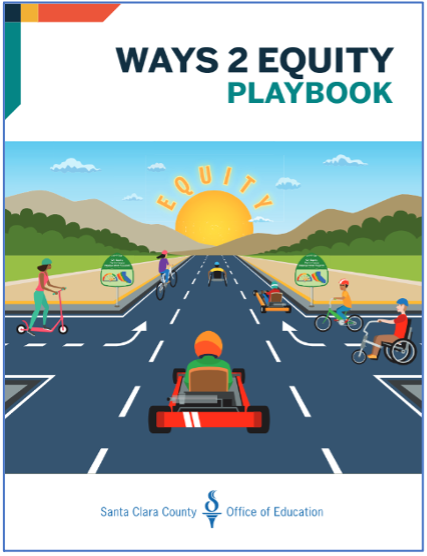
September 2, 2021Under the California Statewide System of Support, the Ways 2 Equity Playbook (W2EPB) is the work of the California Equity Performance and Improvement Program (CEPIP) of the Inclusion Collaborative at the Santa Clara County Office of Education (SCCOE). The two year, 2.5 million dollar CEPIP grant was authorized in 2018 by Assembly Bill 99 to "support and build capacity within County Offices of Education (COEs), Local Education Agencies (LEAs), and schools to promote equity for disadvantaged student populations in California schools."
From this funding, the SCCOE Inclusion Collaborative established the California 1: Highway to Success for All (CA1). One of two state Equity Leads, the SCCOE developed the W2EPB, which is a guidebook for supporting hands-on equity work at the school, LEA, and COE levels with particular focus on the following three student groups: Students who are African American, Students who are English Learners, and Students with Disabilities. Download the free publication and check out the webinar recordings, guides and online learning courses offered at the Inclusion Collaborative website.
Added: Mar 2022
Significant Disproportionality in Special Education: Current Trends and Actions for Impact, National Center for Learning Disabilities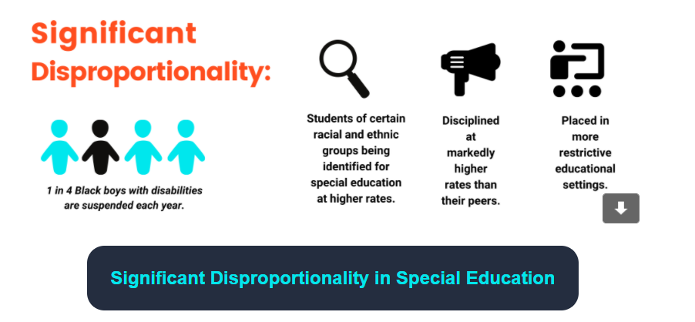
National Center for Learning Disabilities | October 19, 2020Years of research point to inequities in education for students of color, students from low-income backgrounds, and students with disabilities. These inequities are particularly apparent when it comes to rates of discipline and special education enrollment.
Being misidentified as needing special education, placed in a restrictive setting, or disciplined more frequently and harshly can negatively affect student outcomes. To correct and prevent these trends, education professionals and policymakers must first understand the magnitude of significant disproportionality for students of different races and ethnicities.
NCLD created a comprehensive white paper and six accompanying briefs to share data showing how students from specific communities are impacted.
Added: Jan 2021 | Updated: Jun 2021
Start with Equity California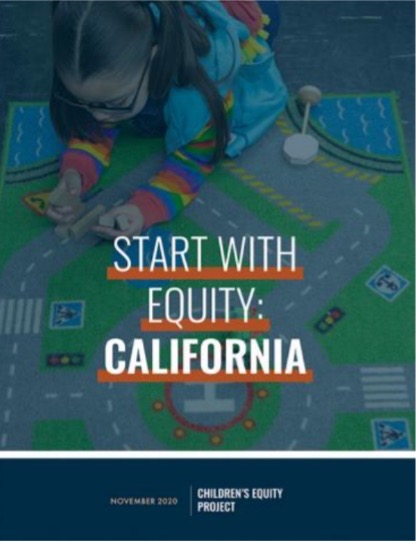
November 2020 “The nation’s early care and education systems are gravely inequitable. Opportunity gaps between children from historically marginalized communities and their peers are consistent, wide, and consequential. In the summer of 2020, The Children’s Equity Project and the Bipartisan Policy Center came together to create an actionable policy roadmap for states and the federal government—as well as for candidates at all levels of government vying for office—to take meaningful steps to remedy these inequities. Read Start with Equity: From the Early Years to the Early Grade.”
As a follow up to that work, the Children’s Equity Project has developed a new report focusing on the state of equity in California’s early care and learning systems in the three key issues covered in the Start with Equity national report, including harsh discipline and its disproportionate application, lack of inclusive learning opportunities for children with disabilities, and inequitable access to bilingual learning for dual language learners. The authors provide a California-specific policy agenda to inform the state’s Master Plan for Early Care and Learning and to build more equitable systems for the state’s youngest learners.”
Added: Jul 2022
Start with Equity: From the Early Years to the Early Grades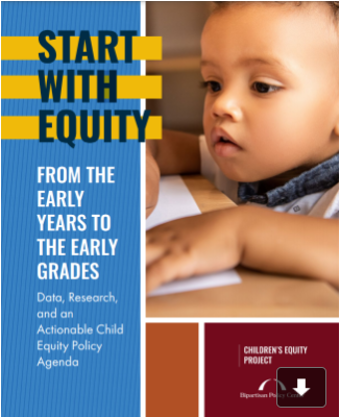
Children's Equity Project and Bipartisan Policy Center Report | 2020The Children’s Equity Project and the Bipartisan Policy Center, with support from the Heising Simons Foundation, released a new report: Start with Equity: From the Early Years to the Early Grades. The report provides a review of the data and research on three key equity indicators and provides an actionable policy roadmap for Congress, federal agencies, states and districts to take meaningful steps to remedy these inequities in early learning and education systems. Briefs on the three key equity indicators are below:
You can find the report and the corresponding four-part webinar series the Start With Equity webpage.
Added: Jan 2021 | Updated: Jun 2021
Viewpoint: Creating Antiracist Early Childhood SpacesNAEYC | Rosemarie Allen, Dorothy L. Shapland, Jen Neitzel, Iheoma U. Iruka | Young Children, Summer 2021The focus on racial equity following the murder of George Floyd has resulted in conversations about racism that were unheard of less than a year ago. A critical examination of race, bias, racial inequity and racism is taking place at every level in our society, and researchers, educators, and advocates have proposed anti-racism strategies for a variety of settings, including in early childhood spaces. To enact and sustain an anti-racist approach, early childhood educators need to understand the racial history of early childhood programs and the racism in current early childhood programs. In this article, we outline the past and present along with strategies for creating anti-racist early childhood spaces.
The content of this article is described in session 3 of the DEC Equity Series: In Pursuit of Equity in Early Intervention/Early Childhood Special Education
Added: Jun 2021
When the Rules are Fair But the Game Isn’tThis article on Linked In describes the research conducted with the use of the Monopoly Game to demonstrate systemic racial injustice.
The original research article can be found here (PDF).
Added: Jun 2021
Zero to Three: Promoting Racial Equity in Early Childhood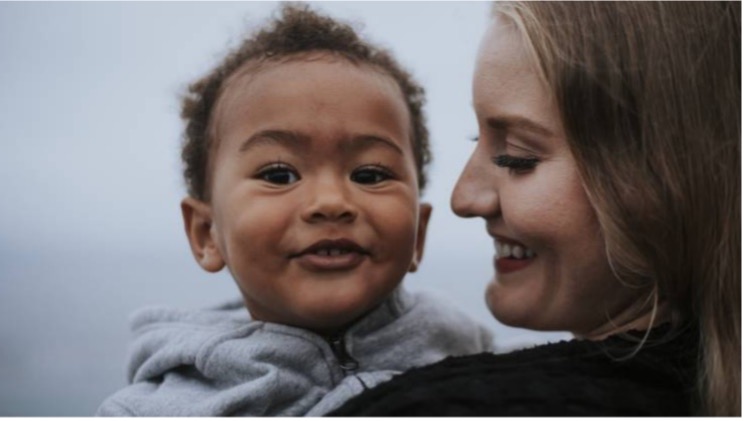
Zero to Three has compiled resources for professionals, parents and policy makers that offer insight and guidance on racial justice and equity issues in early childhood. Together, we will make a better world for our babies — a world in which every baby is valued and loved. Take a look at the article below:
Added: Mar 2022
Racial EquityECTA“Racial equity is the condition that would be achieved if one's racial identity no longer statistically predicted how one fares in life. To achieve racial equity will require seeing differently, thinking differently, and doing the work differently. Racial equity is about results that make a difference and last. These resources focus on the myriad and far-reaching implications of racial inequities in early childhood special education and early intervention. They contribute to individual growth and systems change efforts that center racial equity by highlighting policies, practices, and strategies that can bring about equitable outcomes for children and families.”
Added: Jul 2022
Addressing Elephants in the Room: Equity and Racism Panel Presentation Part 1 (Video)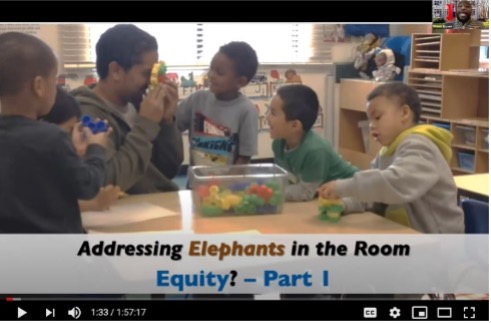
First 5 Alameda County | July 13, 2020 | Length: 1:57:17Shawn Bryant, MA, is the founding director and chief learning officer with Teaching Excellence Center. He is an educational coach, facilitator, and consultant with over 27 years of educational experience in urban, suburban, and rural school district and early learning settings. This informative and instructive webinar will include a panel of equity and anti-racist professionals: Tarah Fleming will present Equity Literacy, Allied Behavior, and Centering Anti-Racism in Our Lives; Zelica Rodriguez-Deams will present Equity Lens vs Equity Mirror - Creating Authentic Community Engagement; and Patricia Nunley will present Helping Children Through A-Up African Ubuntu Pedagogy: Equitable Practices and Interactions.
Download materials for Addressing Elephants in the Room, Part 1 .
Added: Jun 2021
Addressing Elephants in the Room: Equity and Racism Panel Presentation Part 2 (Video)First 5 Alameda County | July 20, 2020 | Length: 2:04:43In the wake of current national events and public statements being released by thousands of schools, businesses, and industry leaders, communities need more. This engaging online presentation will provide thoughtful action that addresses the pervasive racism that continues to kill the spirit of children and families. This session will include: Nnenna Odim presenting Early Learning Environments as AntiRacist Spaces for Black Children; G. Reyes presenting These Are the Breaks: BRAVERY as Liberatory Critical Race Pedagogy.
Download materials for Addressing Elephants in the Room, Part 2.
Added: Jun 2021
Advancing Racial and Ethnic Equity in Head Start Four Part Webinar Series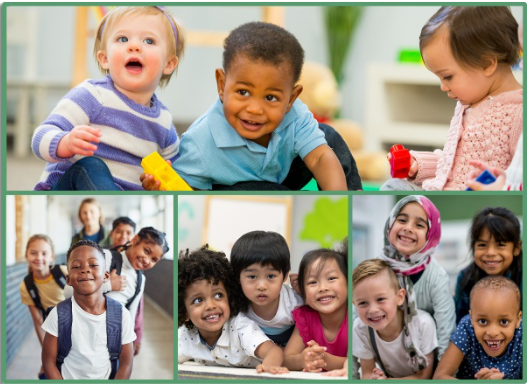
Head Start | September 25, 2020The Advancing Racial and Ethnic Equity in Head Start Webinar Series promotes anti-bias and anti-racism strategies Head Start and Early Head Start programs can use in their practices, services, and systems. It builds upon foundations in the Multicultural Principles for Early Childhood Leaders and the Head Start Program Performance Standards. It also complements Head Start's history of anti-racism in action. Watch the webinars to reflect on individual perspectives and recommit to building program environments that communicate genuine care, value, and respect for all children, families, and staff.
Topics for the four-part series include:
- Exploring terminology and engaging in challenging conversations about racism
- Discussing children's understanding of race and identity development
- Developing anti-bias teaching practices
- Examining principles and policies for human resources systems that honor diversity, equity, and inclusion
- Exploring intersections of health and racial equity to support the wellness of children, families, and staff
Added: Jun 2021
Creating Anti-Racist Early Childhood Spaces (Webinar)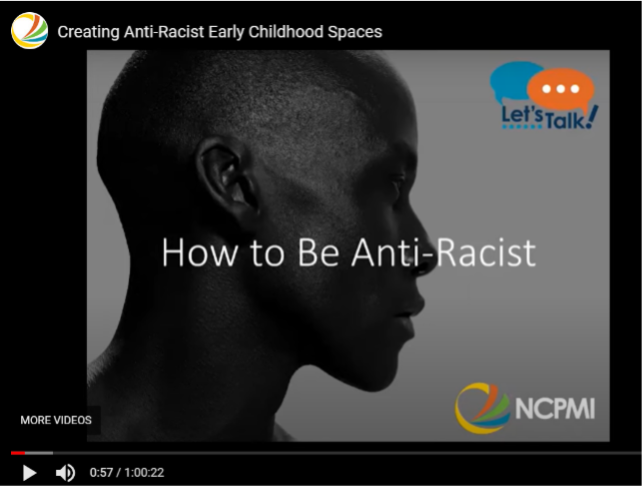
National Center for Pyramid Model Innovations | June 12, 2020Now, more than ever it is important to address issues of race and bias in early childhood settings. Children notice race at a very early age and can begin to categorize people according to skin color. This webinar presents strategies for creating an anti-racist environment to promote the development of healthy racial identities.
Added: Jun 2021
Equity in Infant and Early Childhood Mental Health Consultation (Webinar Series)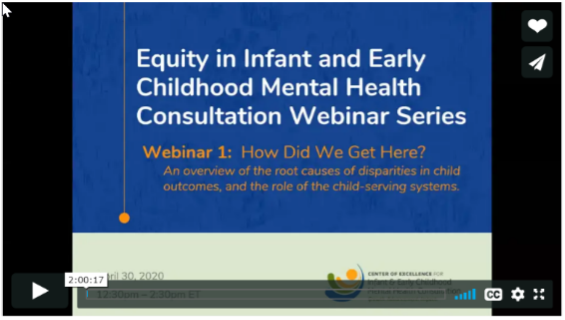
The Center of Excellence | August 2020The Center of Excellence, in partnership with the Children's Equity Project, concluded its four part equity series last month with its final webinar, entitled "Culture, Identity, History as Sources of Strength and Resilience for Latino Children and Families".
The purpose of the Equity in IECMHC Webinar Series is to promote equity through IECMHC by building awareness of the impact of institutional racism and other forms of bias on the experiences of children and families from marginalized communities and identifying policies and strengthening culturally responsive practices that reduce disparities and improve child outcomes. The first webinar, presented in April, explored the historical and societal institution of racism and other forms of bias on the early care and education experiences of children and families from marginalized communities and identified ways to address equity, bias, and disparities through an IECMHC framework.
Available in English and Spanish.
Added: Jun 2021
Understanding Implicit Bias and Its Role in Early Learning Environments (Webinar)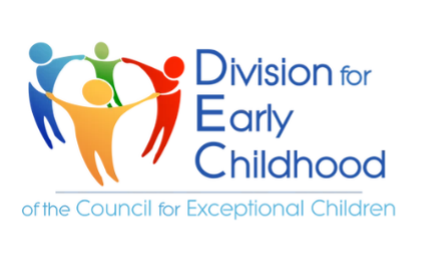
Division for Early Childhood (DEC) | June 6, 2018Description: Racial inequities have long been present in our educational system. Recently, there has been a growing emphasis on the role of implicit bias in how programs discipline children, implement classroom practices, and establish teacher-child relationships. This session aims to support early childhood professionals in reducing implicit biases and using culturally responsive practices. Specifically, the session will focus on (1) identifying barriers to equity in early childhood environments for children of color (L7; E1); (2) defining implicit bias and its role in perpetuating inequitable practices (L7); (3) describing strategies for identifying and overcoming implicit bias (INS6); and (4) providing specific culturally responsive practices that can be used in early learning environments to promote equitable outcomes for children from culturally diverse backgrounds (E1; INS2; INS6). This session will actively engage participants in learning self-reflection and debiasing strategies, and how to use culturally responsive practices.
After taking part in this session, participants will be able to:
- Identify barriers to equity in early education, specifically related to the disproportionate number of Black children who are suspended or expelled from programs.
- Have a basic understanding of implicit bias and its role in early childhood education.
- Describe specific strategies for identifying and overcoming implicit biases.
- Describe the components of a culturally responsive teaching practices, including an emphasis on family involvement, how to view child development through a culturally responsive lens, and specific culturally responsive strategies designed to prevent challenging behaviors within early learning environments.
Added: Jun 2021
From Surviving to Thriving: Creating a Way Forward in Challenging Times (Video)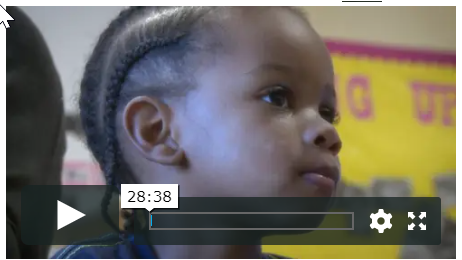
The COVID-19 pandemic has called all early childhood educators to muster our courage and strength like never before. Exchange Press, in collaboration with Hinge Early Education Brokers and Video Active Productions, has created this free video series. Each video has inspiration, support, and practical advice from experts to help you navigate the rough waters of this crisis. Video #8 How to Address Inequities in Early Childhood Education is a 28 minute video that features Walter Gilliam and other experts and includes the history and personal experiences of the experts.
Added: Jun 2021
Reflecting on Anti-bias Education in Action: The Early Years (Video)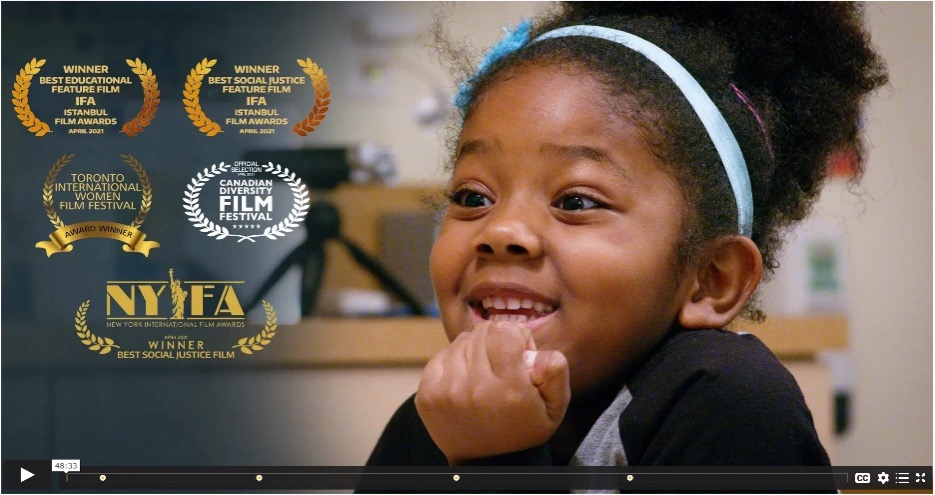
Antibias Leaders In Early Childhood Education | 2021 | Length: 48 minutesThe award-winning short film, Reflecting on Anti-bias Education in Action: The Early Years, is 48 minutes long and features vignettes of anti-bias strategies in early childhood classrooms interspersed with teachers reflecting on their practice. A facilitator and viewer guide are available.
“We partnered with filmmaker Filiz Efe McKinney of Brave Sprout Productions to create a film that shifts the focus away from the talking heads of experts and on to the voices of teachers committed to equity on a daily basis. By taking viewers into diverse ECE classrooms, the film seeks to demonstrate the importance of teacher reflection on identity, context, and practice in anti-bias education and provides a much-needed resource for teacher education and professional development. Here is a recent blog post.”
EmbraceRace.com hosted a screening and discussion
Added: Jun 2021
The Danger of a Single Story – Chimamanda Ngozi Adichie (Video)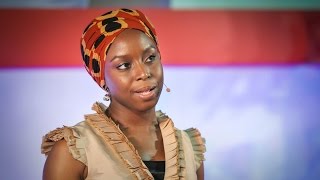
TEDGlobal | 2009 | Length: 18:33 minsOur lives, our cultures, are composed of many overlapping stories. Novelist Chimamanda Adichie tells the story of how she found her authentic cultural voice -- and warns that if we hear only a single story about another person or country, we risk a critical misunderstanding.
Added: Mar 2022
Using Books to Help Build Inclusive Classrooms
Eastern Connecticut Center for Early Childhood EducationThis video won the 2023 Telly Award.
All children should feel welcome in early childhood classrooms. In this video, Dr. Theresa Bouley describes how teachers can carefully select a variety of children's books to ensure that books in the classroom represent a variety of cultures and family structures. She also explains how engaging children in rich pre- and post-reading discussions can foster an appreciation of diverse perspectives and help create inclusive classrooms. The web page includes discussion and reflection questions and related videos:
Added: Sep 2023
Vital Conversations with Young Children About Race (Video)
National Center for Pyramid Model Innovations | June 19, 2020 | Runtime: 28:38In this two-part conversation, Dr. Phil Strain and Dr. Rosemarie Allen tackle some challenging topics and have a frank and important discussion about equity, black lives, and racism. They invite you to listen as they discuss the impact of racism on black children and their families, how to talk to children and families about race, what does it mean to be anti-racist early educator, and the importance of the Pyramid Model practices in efforts to be anti-racist.
Added: Jun 2021
Why diverse children’s books are important tools for teaching kids about themselves and others (Video)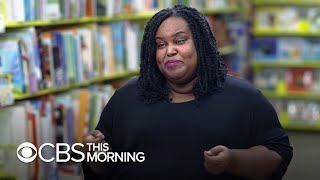
CBS This Morning | July 2021 | Length: 6:33 minutesChildren's books are both mirrors in which kids can feel seen and windows into worlds unlike their own. At Book Culture in Long Island City, NY, "CBS This Morning” co-host Tony Dokoupil learns why both are important.
Added: Jun 2023
12 Inspiring Bedtime Stories for Your Child (featuring girls!)The challenge that parents will encounter, and especially parents of young girls, is inadequate female representation in children’s books. The Minnesota Journal notes that girls are portrayed much less frequently than boys in children’s books, and often in gender-stereotypical terms; for example, many children’s books fall back on cliched portrayals of girls as nurturers, naifs, or damsels in distress; only boy characters are permitted to be valiant, bold, or fierce. Sadly, this is a long-gestating problem. The same article notes that, between 1900 and 2000, there was very little change to female representation in children’s books.
For parents seeking bedtime stories that center around the experience of girls, this blog post describes a few titles that are bound to inspire.
Added: Jun 2021
A Guide for Selecting Anti-Bias Children’s BooksSocial Justice Books It is important to offer young children a range of books about people like them and their family—as well as about people who are different from them and their family. All of the books should be accurate and appealing to young children. Fortunately, there are some good anti-bias children’s books, which are available as a result of the ongoing activism of many individuals and groups over many years. This Guide provides a checklist of thoughtful criteria for you to consider when choosing high quality children’s books to nurture ……a child’s sense of self, positive attitude toward others, and motivation to act for fairness.
Here are recommendations for books related to disability.
Added: Jul 2022
A Kids Book About Belonging (Video)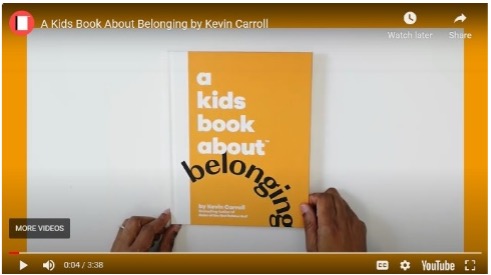
Kevin Carroll | Dec. 2, 2019 | Length: 3:38 minsPowerful Book about how to love who you are.
“This is a book about belonging. It tackles what it’s like when you feel like you belong to a group or family or team and what it’s like when you don’t. It addresses what it feels like when you don’t fit in, or when others don’t want you around. This book teaches kids how to belong to themselves and how that helps them belong anywhere.”
Added: Jun 2021
A Kids Book About Publishing Company“Meet A Kids Book About, a new kind of publishing company. Our mission is to help kids and their grownups have honest conversations by making books about challenging, empowering, and important topics told by diverse authors who know that topic first-hand.”
Several of the books from this publishing company were chosen to be on “Oprah’s Favorite Things for 2020” and are labeled as such. The books in this collection are meant to be a starting point for discussion about all kinds of important topics like empathy, gratitude, change, depression, bullying and many more. Links to videos of two of the books, read by their authors, are below. The books are well written with simple but important messages that will ring true for kids and adults.
Added: Jun 2021
A Kids’s Book About Racism (Video)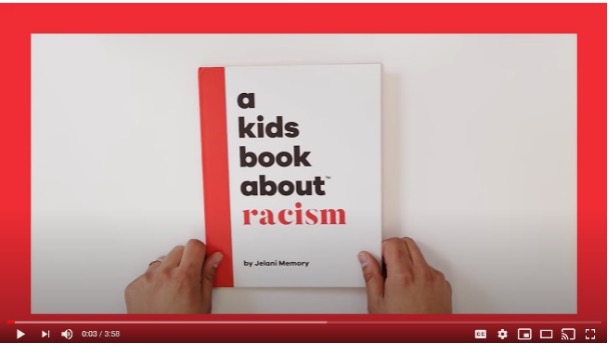
Jelani Memory | December 2, 2019 | Runtime: 3:38“Yes, this really is a kids book about racism. Inside, you’ll find a clear description of what racism is, how it makes people feel when they experience it, and how to spot it when it happens. This is one conversation that’s never too early to start, and this book was written to be an introduction for kids on the topic.”
Added: Jun 2021
Children’s Books to Support Conversations on Race, Racism and Resistance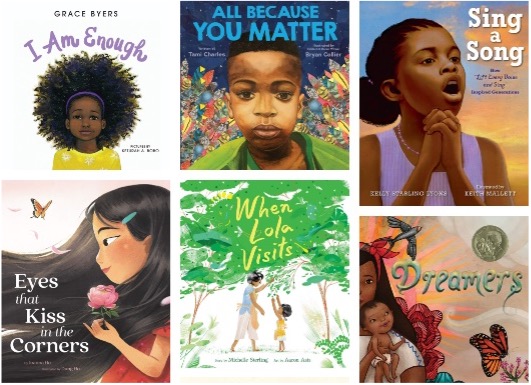
The Conscious Kid identifies a large collection of recently published children’s books that inspire conversations about race, culture and identity. Click on the book and you’ll find a description of the content and the best age range for readers. At this website you’ll also find API Storytime that gives attention to Asian and Pacific Islanders. Celebrities like Harry Shum Jr. read stories that bring forward the stories and voices of this group of frequently overlooked cultures.
Added: Mar 2022
Diversifying Your Classroom Book Collections? Avoid these 7 Pitfalls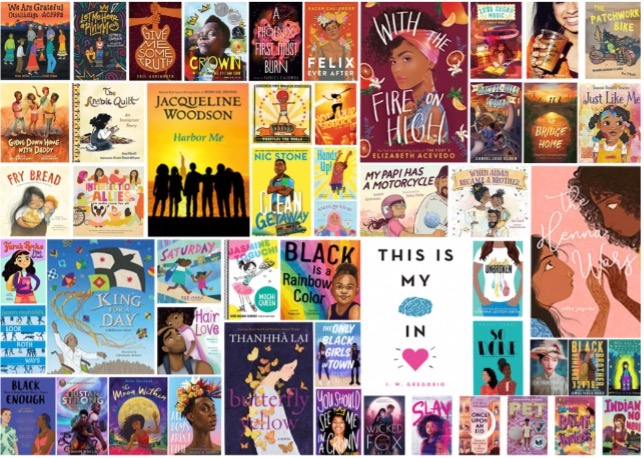
Mind/Shift | December 3, 2020”Building a classroom library that offers “windows, mirrors and sliding glass doors ” to all children is more than a numbers game. It requires thoughtful curation of who is represented and how.”… This article describes seven pitfalls to avoid when deciding what to leave in and out, accompanied by more than 50 title recommendations based on conversations in this piece to help kickstart the journey. Included are picture books and books for middle grades and young adults.
Added: Jun 2021
EmbraceRace.org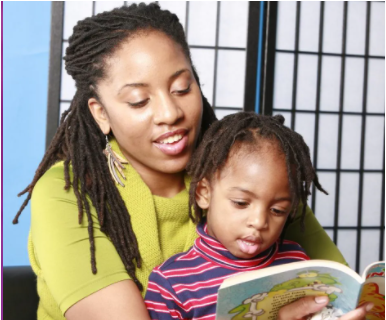
“There is a growing body of research and evidence that makes clear that children’s racial sensibilities begin to form in infancy, that almost all children develop racial and other biases by kindergarten, and that those biases become fairly entrenched by adolescence. And yet, most national organizations dedicated to children’s racial learning direct their resources mainly to middle and high school educators. There are too few resources for young children available for parents, grandparents or other caregivers or for early childhood educators. EmbraceRace helps fill that gap.” Explore the resources by topic area or take a look at the webinars and other resources. Below are a couple of sample topic areas:
Added: Jun 2021
Four Children’s Books About Empathy That Shows That Everyone Matters
Think Inclusive | May 29, 2020“Unfortunately, children often experience a lack of empathy for their differences, both among their peers and among the adults in their lives. Empathy is a learned skill; it can, and should, be taught. These four children’s books about empathy are excellent ways to introduce empathy skills and an appreciation for everyone’s differences.”
My favorite of the recommendations is actually a set of three board books that feature gorgeous photographs of inclusive families and children of all types and abilities. “The Families book portrays LGBTQ+ families, grandparents, and families of many races. Hair celebrates all the various shapes and places and ways hair can be. On-the-Go, pictured here, is a powerful visual celebration of all the ways our bodies can move, and all the different apparatuses that can get us there. On-the-Go can also be paired with this diverse abilities figure set to extend the visual normalization of disability through play.
At only 14 pages each, and just the right size for tiny hands, these books are great for toddlers and preschool classrooms. Teaching acceptance and empathy can begin at any age, and the best way to begin for babies and toddlers is through exposure.
Added: Jun 2021
I Am Every Good Thing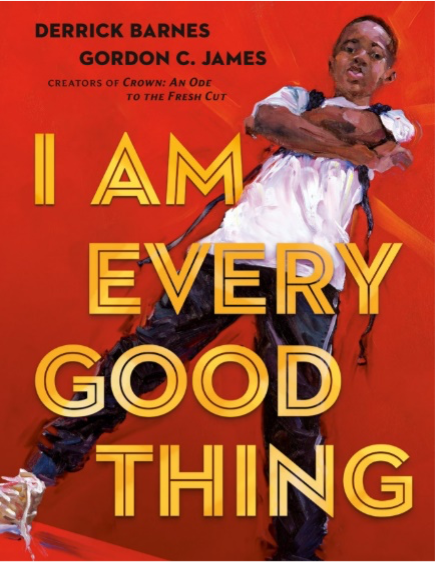
National Public Radio (NPR) | October 24, 2020“The kids in I Am Every Good Thing are compared to the best things: moonbeams on brand new snow, the center of a cinnamon roll, a perfect paper airplane that glides for blocks.
When Derrick Barnes first started writing children's books 15 years ago, he didn't see Black kids — and Black boys in particular — being depicted in this way.
"Whenever you saw a black male character in children's books, he was either playing basketball, he was a runaway slave, or just visually looking very docile or assimilating," Barnes says.
Barnes has four sons of his own and he wrote his new book to be empowering and affirming — two bounces and a front flip off the diving board on a Saturday morning affirming. "I compare our sons to things that are universally good ... to show America that our boys have just as much value as your sons," he says.”
Added: Jun 2021
Sam shares a little inspiration about what kids can be when they grow up (Video)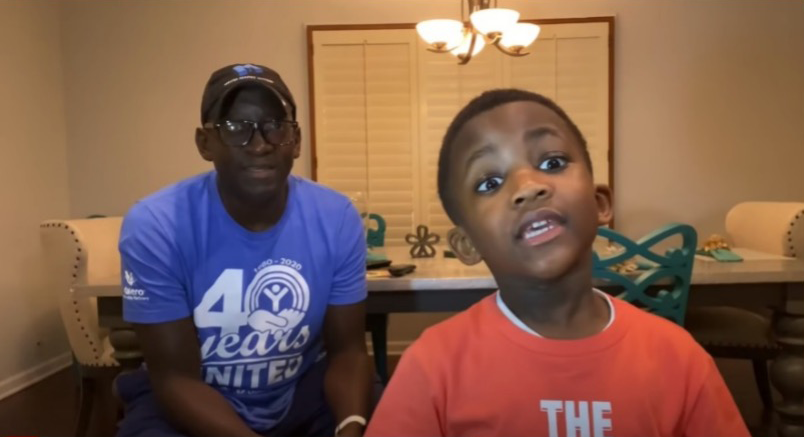
November 2020 | Runtime: 2:30You may have seen this video on social media or on network news. Sam’s performance and his alphabet of all of the possible things can be when they grow up is entertaining and inspiring! Camille Catlett of Faculty Finds supported by EduAlliance, challenges you as a teacher or a parent to find ways to use this video as a starting point for conversations and activities with kids.
"What might it be like to: …"
- "Have a conversation with children about each of the professions mentioned?"
- "Take each letter of the alphabet and consider other careers that also start with that letter?"
- "Take any of the careers and spend a day talking about it? For example, “H” is for hospital administrator. What is a hospital administrator? Where does she/he work? What do they do? Who are their colleagues? Or just enjoy the flow and then have a conversation with children to learn if they know any other raps or songs about jobs."
Added: Jun 2021
Sesame Street Racial Justice: Coming Together-The ABC’s of Racial LiteracySesame Street"All kids need a strong individual and group identity, but racism hurts the healthy development of both. Racism hurts our entire society. Whether you and the children in your care are directly affected by racism or you’re allies of those who are, engaging honestly and directly with little ones is the beginning of building racial literacy (the skills needed to talk thoughtfully about race and to identify and respond to racism). Here are resources to develop children’s understanding, curiosity, resilience, and empathy—and to prepare for the task of building a better world by standing up, standing tall, and standing together.”
Find videos, activities and articles that help to provide an understanding of racial literacy.
Added: Jun 2021
The Power of We (Video)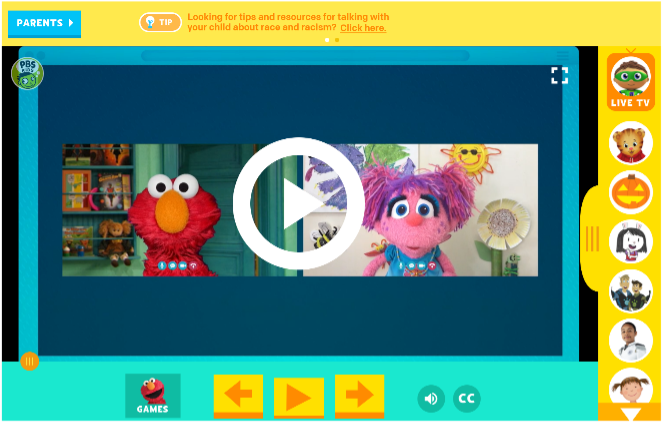
The Power of We: A Sesame Street Special centers on four friends: Elmo, Abby Cadabby, Gabrielle, and Gabrielle’s older cousin, Tamir. With other Sesame Street neighbors and celebrity guests, the friends explore their own identities and skin and fur colors and come to understand what it means to be color-proud—to have pride in your own culture, identity, and race. In age-appropriate ways, the friends learn what each of us can do to stand up to racism for ourselves and one another through one powerful little word: we.
Added: Jun 2021
Therapist Starts Bedtime Story Series Read by Black Men Featuring Books With Black Children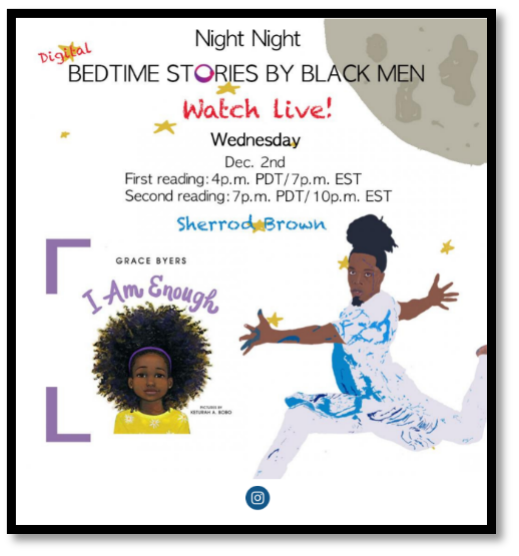
“Every Wednesday night at 7 p.m., children are tuning in to a new online series called “Night Night” where African American men read bedtime stories featuring children of color.”
“The series is the brain child of Long Beach family therapist Brad Scott.
While Brad reads, his dad plays relaxing jazz guitar in the background so kids can settle in for story time. Scott says as a kid, he fell in love with books after attending readings at the Long Beach public library.”
"How important it was for me to have Black men read to me, even though there was only a few times that Black men showed up to read, it was just important to see them be silly and engage with us as kids," he said.
“Night, Night” readings on You Tube give you an opportunity to experience the bedtime stories read lovingly and thoughtfully by black men. You’ll appreciate the positive impact the readings may have on any child.
Here are a sample:
Added: Jun 2021































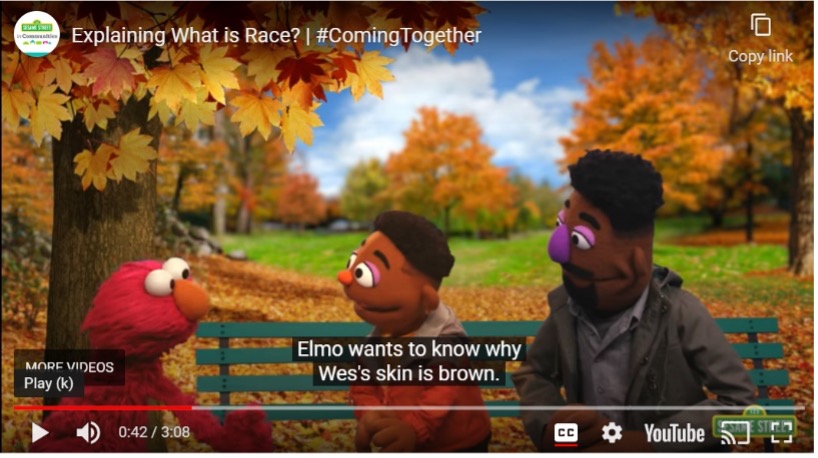
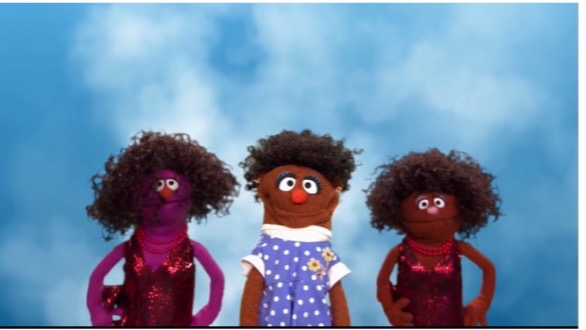 Happy Women’s History Month! Celebrating strong women who have helped change the world!
Happy Women’s History Month! Celebrating strong women who have helped change the world! 

